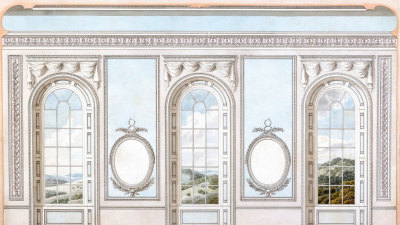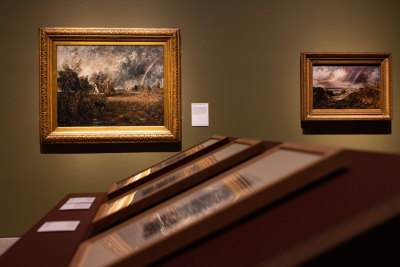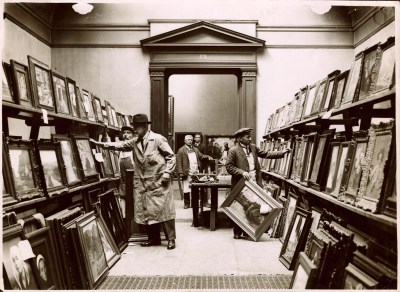
J.M.W. Turner RA, Dolbadern Castle, North Wales, 1800.
Oil on canvas. 1194 mm x 902 mm, Weight: 35.15 kg. © Photo: Royal Academy of Arts, London. Photographer: Prudence Cuming Associates Limited.
This image is not available to download. To licence this image for commercial purposes, contact our Picture Library at picturelibrary@royalacademy.org.uk
Dolbadern Castle, North Wales, 1800
J.M.W. Turner RA (1775 - 1851)
RA Collection: Art
Silhouetted against the sky, Dolbadern Castle dominates mountainous terrain. Below, soldiers keep guard over a kneeling prisoner. Turner exhibited this at the Royal Academy in 1800, accompanied by lines of poetry alluding to ‘Owen’ (Owain), a thirteenth-century Welsh prince said to have been imprisoned in the castle by his brother for over twenty years.
How awful is the silence of the waste,
Where nature lifts her mountains to the sky.
Majestic solitude, behold the tower
Where hopeless OWEN, long imprison’d, pined,
And wrung his hands for liberty, in vain.
The theme of lost liberty had contemporary resonance. During the 1790s, the fear that revolution would spread from France to Britain led the government of William Pitt the Younger to curtail personal freedom by a series of repressive acts of Parliament. Here, the breaking dawn suggests future hope.
When Turner was elected as an Academician in 1802, he offered the RA Council a choice of two Diploma Works; Dolbadern Castle was approved unanimously. Note that the castle itself is now normally spelt Dolbadarn.
This is one of Turner’s earliest dozen or so oil paintings, although he had been exhibiting watercolours since 1790. Castles, especially Welsh ones, were one of Turner’s themes at the time: in the previous year he exhibited two paintings of other Welsh castles (Harlech and Kilgarran, now called Cilgerran); and in both 1799 and 1800 he exhibited watercolours of Caernarvon Castle. In 1798 he exhibited a painting of Dunstanborough Castle and a watercolour of Norham Castle, and in 1800 a watercolour of Warkworth Castle, all in Northumberland.
This poetry seems to have been written by Turner, the first time he used his own poetry in the RA Annual Exhibition catalogue (Wilton, 1980 p.40) and has been compared to the style of Thomas Gray (Butlin and Joll, 1984, p.10). The particular comparator is Gray’s poem The Bard, published in 1757. Shanes questions the assumption that the lines were written by Turner, suggesting they ‘seem too fluent for a poet-manqué.’ (Shanes, 1990b, p.60) The poetry and inclusion of a specific historical figure adds high-status History to what is primarily a landscape painting. ‘A historical dimension is introduced into a sublime landscape without compromising its simple and generalised treatment.’ (Wilton 1987, p. 39) Wilton notes that Turner uses the verse to complement the visual image by adding historic content and introducing concepts (for example, ‘awful … silence’) that are not easily rendered visually. ‘All the qualities of the natural scene at Dolbadarn are given additional force by being related to the experience of a specific human being – “hopeless Owen”’ (Wilton, 1980, p.40). ‘Owen’ is the Welsh prince Owain Goch ap Gruffydd, who was imprisoned in Dolbadarn Castle by his brother for over 20 years. (Owain Gogh was imprisoned in 1255, after losing the Battle of Bryn Derwin to his brother Llywelyn the Last (died 1282), prince of Gwynedd, after a family feud (Humphries, 1995, p.11); the location of imprisonment in Dolbadarn Castle is now disputed.)
As well as referring to the particular case of Owain, the poem introduces a general idea, liberty. ‘The simultaneous suggestion of a hero and a universal idea in the context of the gloomy Welsh mountains creates a complex play of ideas visual, moral and political which Turner may well have considered worthy of the attention of his fellow academicians.’ (Wilton, 1980, p.42) Shanes goes further, noting that the picture shows dawn light, suggesting ‘something hopeful here, namely liberty. At present Owain pines for this “in vain”… but eventually he will regain it… There were a number of artists… at the Royal Academy who were very alert to the suppression of liberty in Britain. (Shanes, 1990b, p.61 and pp.69-70) Shanes notes that Turner exhibited two other paintings dealing with the theme of liberty at the RA in 1800: The Fifth Plague of Egypt and Caernarvon Castle. He suggests that in these works, particularly Dolbadern, Turner ‘may have been taking some anti-government stand’ at a time when discussions of democracy and royal power were even shaping relationships within the RA itself (Shanes, 1990a, p.40 and p.45) . Barry Venning summarises the argument, ‘Dolbadern Castle, with its theme of lost liberty, also had strong contemporary resonances. During the 1790s, the fear that revolution would spread from France to Britain led the government of William Pitt the Younger to curtail personal freedom by a series of repressive acts of parliament.’ (Venning, 2003 pp.51-2) In the National Library of Wales oil study (see Related Works, below) the foreground figures have been identified as Owain, in a red tunic, being led by soldiers to the castle (National Library of Wales online catalogue entry). In the finished picture the figures have previously been mistaken for bandits – it was exhibited at the British Institution in 1854 as Landscape with Banditti. Shanes identifies four figures, ‘two soldiers standing guard over a kneeling prisoner whose wrists are bound behind him, and another seated figure who is pointing at the castle.’ (Shanes, 1990b, p.60) He observes that Owain is aligned vertically with light shining from a window in the castle tower, where he, by implication is about to be imprisoned. The building dominates our view of the scene and will soon dominate Owain. Elsewhere, Shanes notes the effect of imprisonment is accentuated ‘by situating Dolbadarn Castle… within an extremely confining space formed by the adjacent mountains [projecting] an appropriate sense of entrapment.’ (Shanes, 2016, pp.191-2)
Dolbadarn Castle is near Llanberis in north Wales. Shanes notes that compared to topographical reality, Turner considerably heightened the tower and the mountains, increasing the dominance of the castle and narrowing the valley. (Shanes, 1990b, p.61) Paraphrasing Turner’s accompanying poem, Humphries comments that Turner lifted the castle ‘towards the sky’, depicting it in dramatic silhouette. He reports on a modern attempt to identify Turner’s viewpoint, ‘When the photographers for this booklet were trying to match [Turner’s view, it became clear that] he has almost completely ignored reality for it is impossible to obtain such a view; the castle tower has been heightened, the mountains raised and the whole valley narrowed.’ (Humphries, 1995, p.11; modern photograph of the view on p.44). The relationship between topography, sketches, studies and painting is complex. It seems that the studies and the painting combines sketches that were made from several different viewpoints.
As Butlin and Joll note, the figures exemplify a recurrent sublime Turnerian theme of humans dwarfed by nature. Wilton, perhaps joking, says the figures include ‘soldiers and what appears to be a half-naked and bound woman’ (1987, p.17). Around that date, Townsend noted that the work ‘has darkened so much that the figures in the foreground are difficult to see.’ (Tate, 1993, p.74) The picture has since been conserved, in 1994. It was also conserved in 1966.
The painting is described as sublime and having ‘gloom and Salvator-like glints of armour’ by Gage (1969, p. 56). Wilton says ‘it is painted in the boldly sublime language of Richard Wilson, broad in handling with strongly organized elements of cloud, cliff and lonely tower.’ (1987, p.17) Philippa Simpson and Martin Myrone describe the work as ‘an exercise in the manner of Salvator Rosa – an artist widely admired for the sublime wildness of his scenes, but also for expressing an imaginative freedom in defiance of all rules.’ They argue that Turner’s explicit references to Salvator Rosa would have suggested meanings of desolation, solitude and danger to contemporary viewers. ‘His aim was to maximise the expressive potential of the chosen motif, and of landscape as his chosen genre. This was where his appropriation of “savage” Salvator came into play… Turner borrowed more than a strikingly sombre palette, and a familiar iconography of rugged mountains and armed figures, [Rosa also taught Turner] how to arrest the viewer’s eye within a claustrophobically confined foreground space from which we seek to escape by moving rapidly upwards… In so doing the composition invites us to experience the feeling of imprisonment , and the attendant longing to be free – to put ourselves in Owen’s place… but at a distance that allows us to identify with the power of the sublime.’(Tate, 2009, pp.124, 126-7). It has been described as ‘perhaps his most carefully planned picture to date’ (Humphries, 1995, p.11).
Shanes (1990b, p.126) notes the historical anachronism, of a type common in Turner’s work, that Owain and his captors are shown in the 13th century, but the castle is shown mainly in its ruined 18th-century state. Shanes draws a parallel between the incarceration of one family member by another in the story of Owain with Turner’s mother’s presence in an asylum. He speculates, ‘if such a parallel was intended, then maybe the painting was created to assuage a profound sense of guilt. And if that was the case, then in purely autobiographical terms Dolbadern Castle, North Wales is Turner’s most deeply personal utterance. Before long he would give it away, perhaps because he found it impossible to live with.’ (Shanes, 2016, pp.191-3).
Related Works
Turner sketched Dolbadarn Castle on trips to Wales in 1798 and 1799 in his North Wales, Hereford Court and Dolbadarn sketch books. A pastel study in the Studies for Pictures sketchbook (Tate D04128; Turner Bequest LXIX 112; http://www.tate.org.uk/art/artworks/turner- study-for-the-composition-of-dolbadern-castle-north-wales-d04128) and an oil study for the painting (National Library of Wales; https:// www.llgc.org.uk/en/discover/digital-gallery/pictures/turner-and-wales/ dolbadarn-castle/) show the castle heightened in a comparable way to the painting. There are other studies, including a study of bound figures. For discussion see in particular Tate online catalogue entry for D04118; Turner Bequest LXIX 103; http://www.tate.org.uk/art/research- publications/jmw-turner/joseph-mallord-william-turner-study-for-the- composition-of-dolbadern-castle-north-wales-r1177996)
A further watercolour study (Tate D04166; Turner Bequest LXX-O;) shows the castle at a much lower elevation that the painting.
Object details
1194 mm x 902 mm, Weight: 35.15 kg
Associated works of art
1 results
Start exploring the RA Collection
- Explore art works, paint-smeared palettes, scribbled letters and more...
- Artists and architects have run the RA for 250 years.
Our Collection is a record of them.




